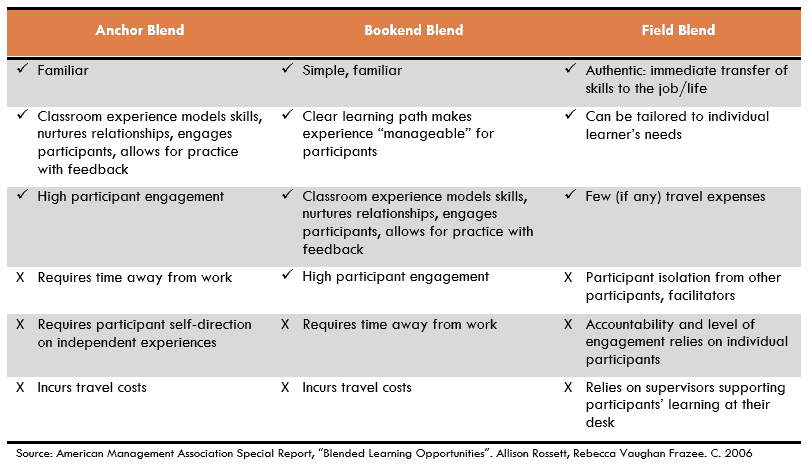By Terri Harrell, M.A.
One of the biggest challenges to the success of a blended learning program is that it be experienced as one program rather than multiple components.

Each component needs to build off the one before, skills need to be linked and reinforced, and participants need to be mapped into where they’ve been, where they are, and where they are going. To ensure you achieve an integrated approach, you must begin with the end in mind by considering several factors during the design phase. Those include understanding program requirements, identifying the best program structure to achieve requirements, deciding what learning methodologies will work for the content and the environment, matching the content to the methodology, and identifying how to measure the success of the program. The remainder of this article discusses ways to ensure you begin with the end in mind.
Gathering Requirements
Before diving into content or technology, it is important to gain a full understanding of program requirements. To do this, there are many questions that need to be answered. Below are typical questions organized by categories.
• The organization –
What does the organization hope to gain from the learning experiences?
What is the culture or organizational norms around what the organization hopes to gain?
What are the norms around training and development?
• The target audience –
What will the population expect in terms of training?
What will they tolerate?
• The content –
What content will best achieve the organization’s goals?
What content will lead to behavioral change in the participants?
• The instructors –
Who will facilitate the learning?
• The logistics –
What is the budget?
Are there travel/infrastructure constraints?
From the Answers to Key Questions Comes:
1. Program Goals – outlines the overarching targets and focus of the program.
2. Objectives – defines the desired measurable learning objectives participants will achieve upon program completion.
3. Learning Outcomes – defines the means through which participants will demonstrate proficiency in learning and realizing the objectives established for the course.
Program Structure
Types of Blends:
1. Anchor blend: Initial classroom experience followed by independent experiences
2. Bookend blend: Initial and closing experiences with classroom
3. Field blend: Employee-centric independent and facilitated experiences
Example of high-level pros and cons of each:

Methodologies
Blended learning programs typically feature the following blend of methodologies, among others:

Matching Content to Methodology
One way to match content with method is to use the Tell–>Show–>Do–>Transfer framework. Depending on the content, the learning stages can be addressed through different methodologies.
For instance, the Tell and Show may be achieved through online training. This provides the participant the foundation before trying the skill. The Do may be an exercise or role-play in the classroom, and the Transfer may be in a learning team or rotational assignment.

Establishing Metrics
There are as many ways to evaluate a blended learning program as there are program possibilities. Examples of metrics include:
• End of Course Evaluations – Conduct level 1and level 2 evaluations at the end of all classroom sessions and distance learning sessions. These evaluations should collect information such as overall course reactions, quality of materials and instructors, and data on level of learning for each content area taught during the session. Use this data to refine approach throughout the program.
• Pre- and Post Multi-Rater Skills Assessment – Conduct a multi-rater assessment on the competencies targeted in the program prior to commencement of the program and again 6 months after program completion. Compare participants’ level of proficiency for each competency from the pre-assessment to that of the post-assessment. Data can be analyzed for each competency for the group as a whole and for relevant sub-groups. This is considered a Level 3 Evaluation – Behavior on the Job or Level of Learning
• Questions at the end of the Post Multi-Rater Skills Assessment – Add both forced choice and open ended questions to the end of the participant version and the supervisor version of the post multi-rater skills assessment. The purpose of the questions on the participant version is to evaluate how well participants are able to utilize new skills on the job as well as to evaluate the effectiveness of the coaching aspect of the program. The questions at the end of the supervisor version are to evaluate the impact the participants’ involvement in the program had on the organization (e.g., participants’ change in skill level, impact of having the participant out of the job, etc.). This is considered a Level 3 Evaluation – Behavior on the Job or Level of Learning.
• Organizational Impact Study – Collect initial and post-program evaluation data such as how participants faired in relation to employees of the same level in the areas of retention, promotion, and awards. This is considered a Level 4 – Organizational Impact.

